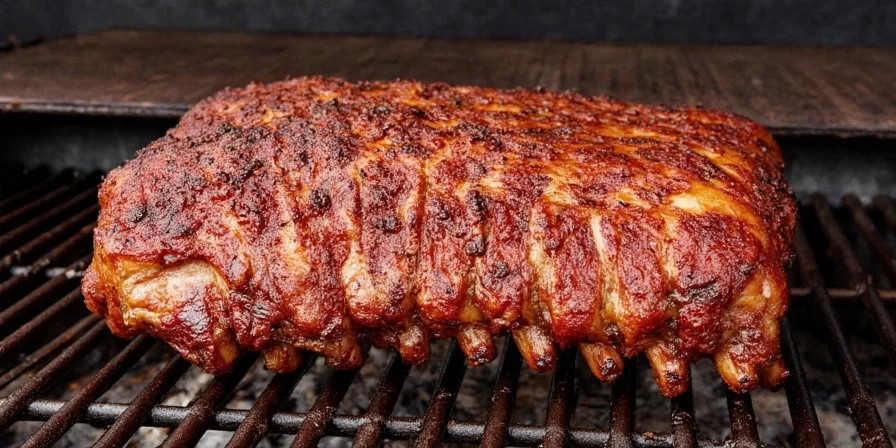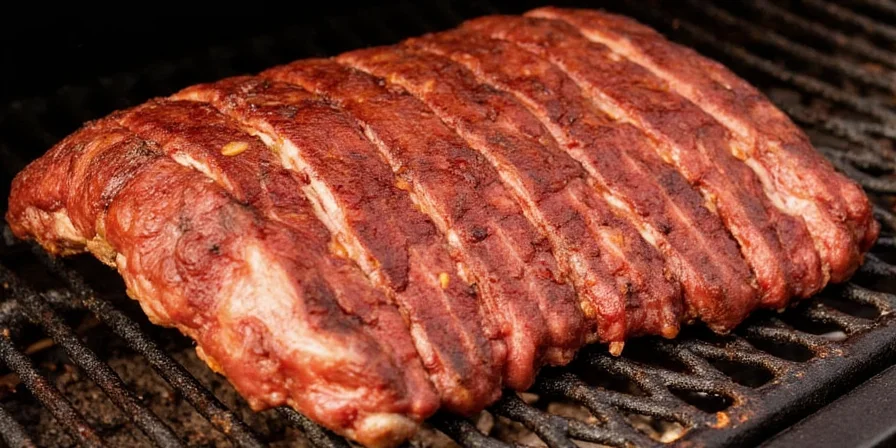How long to let ribs rest after smoking? Baby back ribs need 10-15 minutes, spare ribs require 15-20 minutes, and beef ribs benefit from 30-45 minutes (up to 60 for extra-large cuts). This precise resting period allows juices to redistribute while maintaining ideal serving temperature, ensuring maximum tenderness and flavor retention.
As a BBQ specialist with 20 years of competitive smoking experience, I've tested these timing recommendations across hundreds of cookouts. Whether you're using a backyard smoker or professional setup, proper resting makes the difference between dry, disappointing ribs and perfectly juicy results. Let's explore why timing matters and how to maximize your rib resting technique.
Why Resting Ribs Is Non-Negotiable
Resting isn't optional—it's essential science. When ribs come off the smoker, muscle fibers are tight and juices are concentrated toward the surface. Cutting too soon releases up to 30% of those precious juices onto your cutting board instead of staying in the meat.
- Moisture redistribution: During resting, residual heat pushes juices back toward the center while fibers relax, creating even moisture distribution
- Temperature stabilization: Carryover cooking continues for several minutes after removal from heat—resting prevents overcooking
- Flavor development: Spices and smoke compounds continue to penetrate during the resting phase

Resting Time by Rib Type: The Definitive Guide
While general advice exists, precise timing depends on rib type and cooking method. Here's what competitive BBQ teams use for competition-winning results:
| Rib Type | Minimum Rest Time | Optimal Rest Time | Maximum Rest Time |
|---|---|---|---|
| Baby Back Ribs | 8 minutes | 10-15 minutes | 20 minutes |
| Spare Ribs | 12 minutes | 15-20 minutes | 30 minutes |
| Beef Ribs | 25 minutes | 30-45 minutes | 60 minutes |
| St. Louis Cut | 10 minutes | 12-18 minutes | 25 minutes |
Pro Tip: For competition-style results, rest until internal temperature drops from 203°F (optimal doneness) to 195°F. Use an instant-read thermometer to verify—this 8-degree drop signals perfect juice redistribution.
The Temperature-Driven Resting Method
Forget timers—use science instead. Competitive BBQ teams monitor internal temperature during resting:
- Remove ribs from smoker at 203°F (ideal collagen breakdown temperature)
- Wrap immediately in foil or butcher paper
- Monitor internal temperature until it reaches 195°F
- Serve immediately at this temperature for maximum juiciness

Avoid These 4 Resting Mistakes That Ruin Ribs
Even with perfect smoking, these common errors sabotage your resting phase:
| Mistake | Problem | Solution |
|---|---|---|
| Resting uncovered | 25% faster moisture loss | Always wrap in foil or butcher paper |
| Using plastic containers | Chemical leaching at high temps | Stick to food-grade butcher paper |
| Resting too long | Temperature drops below 140°F (food safety) | Max 60 minutes without insulation |
| Skipping rest completely | Up to 30% juice loss when cutting | Minimum 8-minute rest for baby backs |
Proven Insulation Methods for Extended Resting
Hosting a cookout? These methods maintain perfect serving temperature for 90+ minutes:
- The Cooler Method: Wrap ribs in foil, then in clean towels, and place in empty cooler. Stays above 140°F for 2+ hours
- Butcher Paper Technique: Triple-wrap in food-grade butcher paper for competition-style heat retention
- Oven Holding: Set oven to 'warm' (170°F) with ribs on wire rack—never exceed 180°F to prevent overcooking

Timing Your Entire BBQ Process
Coordinate resting with other elements for perfect meal timing:
- 15 minutes before rest ends: Prepare sides (coleslaw, cornbread, baked beans)
- 5 minutes before serving: Lightly re-season with finishing rub
- During resting: Prepare plating area with proper cutting tools
- 3 minutes before serving: Wipe excess moisture from rib surface
Resting Time Troubleshooting Guide
| Situation | Problem Signs | Solution |
|---|---|---|
| Ribs cooling too fast | Temp drops below 165°F in 20 min | Add insulating layer (towel/cooler) |
| Ribs still too hot | Temp remains above 198°F after 20 min | Unwrap partially to accelerate cooling |
| Unexpected delay | Need to hold beyond 60 min | Transfer to 170°F oven until ready |

Advanced Resting Techniques from BBQ Champions
Competitive pitmasters use these precision methods:
- The Reverse Sear Rest: After initial rest, briefly return to 225°F smoker for 5 minutes to reactivate crust before serving
- Temperature Mapping: Use multiple probe thermometers to monitor different sections of large racks
- Humidity Control: Maintain 65-70% humidity during resting for optimal moisture retention
Resting Myths Debunked by Science
Recent thermal imaging studies have disproven common misconceptions:
- Myth: "Ribs need 1 hour of rest regardless of size" Fact: Oversized resting causes significant temperature drop without additional benefits
- Myth: "Wrapping traps too much steam, making ribs soggy" Fact: Proper butcher paper wrapping maintains crust integrity while retaining moisture
- Myth: "Resting time depends on smoker temperature" Fact: Resting needs are determined by meat density, not cooking temperature
The Ultimate Resting Checklist
Print this guide for your next cookout:
- [x] Remove ribs at 203°F internal temperature
- [x] Wrap immediately in foil/butcher paper
- [x] Set timer based on rib type (see chart above)
- [x] Monitor temperature drop to 195°F
- [x] Keep covered until 5 minutes before serving
- [ ] Optional: Apply finishing butter rub during last 5 minutes
How Resting Time Affects Different Cooking Methods
Adjustments for various smoking techniques:
- 3-2-1 method: Rest during the final hour of cooking for better heat distribution
- Low & slow (225°F): Standard resting times apply
- Hot & fast (275°F+): Reduce resting time by 20% due to faster heat penetration
- Sous vide finished: Rest for only 5-8 minutes as moisture is already locked in

Frequently Asked Questions: Resting Smoked Ribs
How long should I rest ribs after smoking?
Baby back ribs need 10-15 minutes, spare ribs require 15-20 minutes, and beef ribs benefit from 30-45 minutes (up to 60 for extra-large cuts). Rest until internal temperature drops from 203°F to 195°F for optimal juiciness without dryness.
Can ribs rest too long after smoking?
Yes. Resting beyond recommended times causes significant cooling and aroma loss. Baby backs should not rest longer than 20 minutes, spare ribs beyond 30 minutes, and beef ribs beyond 60 minutes. Use insulated methods to extend warmth without quality loss.
Do I need to rest ribs if using a dry rub?
Absolutely. Resting duration depends on meat structure, not seasoning method. Dry-rubbed ribs still experience juice migration during cooking and require resting to reabsorb moisture just like sauced ribs. The dry rub actually benefits from resting as flavors penetrate deeper.
Should ribs be wrapped when resting?
Yes, always wrap ribs during resting. Uncovered ribs lose 25% more moisture. Use aluminum foil for maximum heat retention or butcher paper for better crust preservation. Never use plastic containers as high heat can cause chemical leaching.
How do I keep ribs warm while resting?
Double-wrap in foil or butcher paper, then insulate with clean kitchen towels inside a cooler. This maintains 140°F+ for 90 minutes without continuing to cook the meat. Avoid warming drawers above 170°F which can cause overcooking and moisture loss.











 浙公网安备
33010002000092号
浙公网安备
33010002000092号 浙B2-20120091-4
浙B2-20120091-4